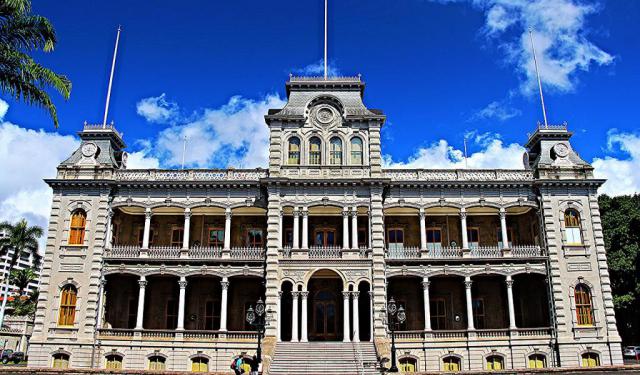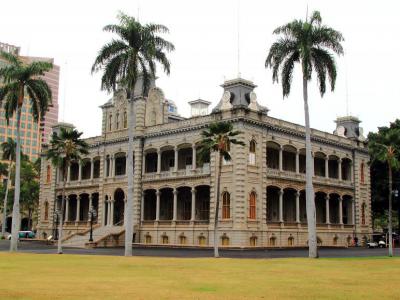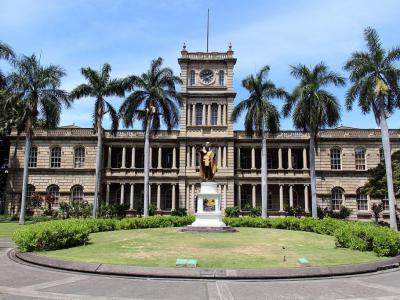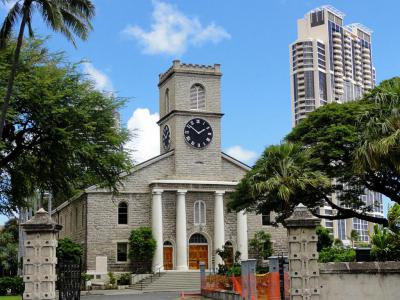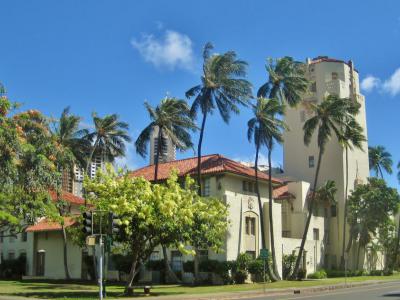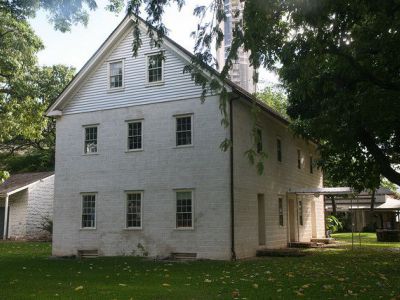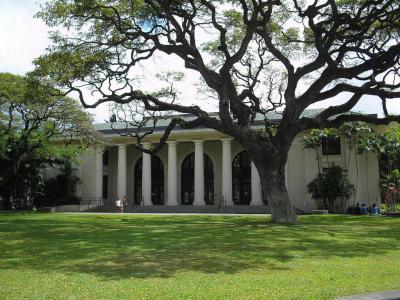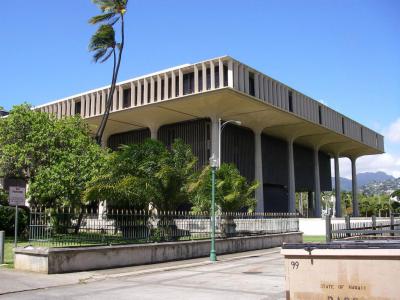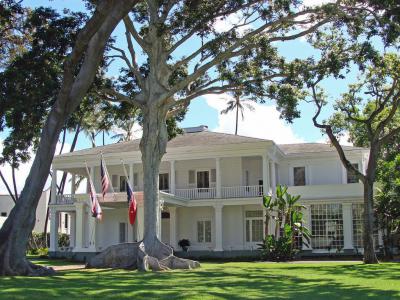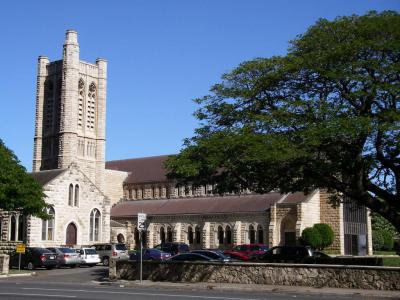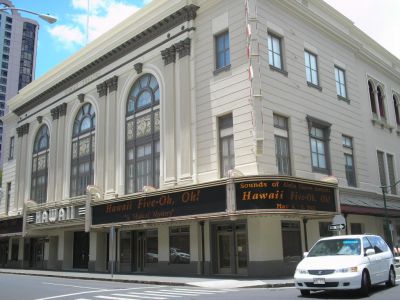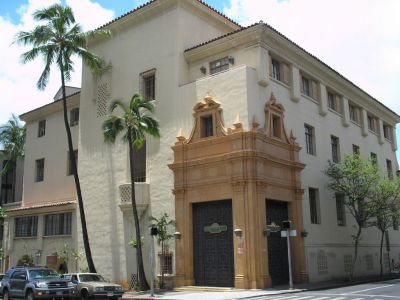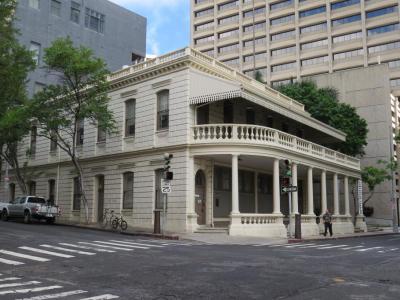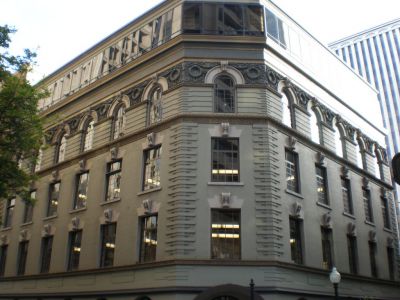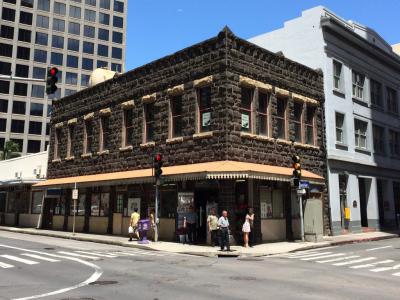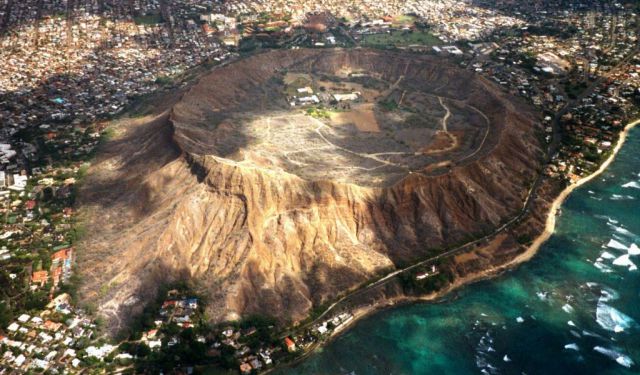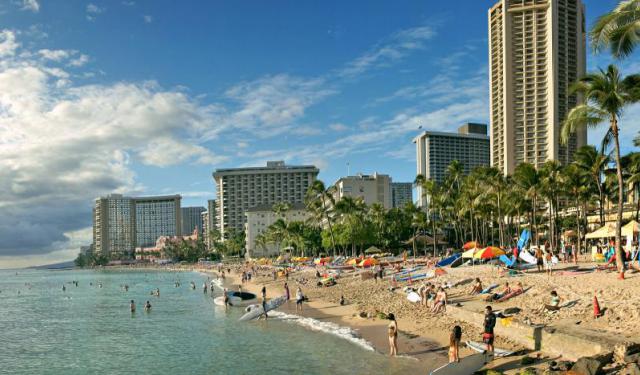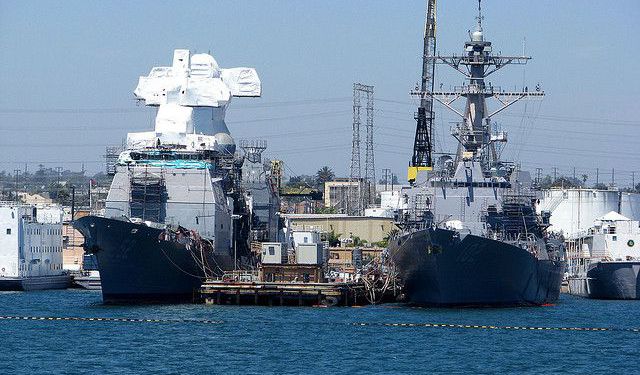Honolulu Downtown Walking Tour (Self Guided), Honolulu
Honolulu is the largest city in Hawaii and the state's capital. Visitors flock here to enjoy the pristine beaches, beautiful scenery and unique culture. There is much to see and do in Honolulu.
The first residents of Honolulu were probably settled during the 11th century. These Polynesian migrants are thought to have come from Tahiti. King Kamehameha I conquered Oahu and claimed the area around Waikiki in 1804. Though the capital of the Hawaiian Kingdom moved over the years, it was eventually King Kamehameha III who established a permanent center of power in Honolulu with the erection of the Iolani Palace.
Hawaii was annexed by the United States in 1898, however, the statehood didn't follow until 1959. Within that time, Hawaii had suffered no shortage of tragedies. The Chinatown fire of 1900 burned for 17 days, destroying more than 4,000 homes over a span of 38 acres. This disaster is often overshadowed by the Japanese attack on Pearl Harbor during World War II that caused 2,403 deaths. Today more than two million people visit the Pearl Harbor National Monument each year to commemorate the event.
Although Hawaii is best known for its beautiful beaches and seaside activities, the Honolulu downtown is also rich in historical and architectural landmarks. The Iolani Palace is by far one of the top attractions. Other standouts not to be missed include the House of Heavenly Kings, City Hall and the Kawaiahao Church. If you want to learn more about the early connection between the Hawaiian kingdom and the continental US, visit the Hawaiian Mission Houses and the Washington Place.
This self-guided walking tour takes you to explore the must-see attractions, historical sites and architectural highlights in downtown Honolulu.
The first residents of Honolulu were probably settled during the 11th century. These Polynesian migrants are thought to have come from Tahiti. King Kamehameha I conquered Oahu and claimed the area around Waikiki in 1804. Though the capital of the Hawaiian Kingdom moved over the years, it was eventually King Kamehameha III who established a permanent center of power in Honolulu with the erection of the Iolani Palace.
Hawaii was annexed by the United States in 1898, however, the statehood didn't follow until 1959. Within that time, Hawaii had suffered no shortage of tragedies. The Chinatown fire of 1900 burned for 17 days, destroying more than 4,000 homes over a span of 38 acres. This disaster is often overshadowed by the Japanese attack on Pearl Harbor during World War II that caused 2,403 deaths. Today more than two million people visit the Pearl Harbor National Monument each year to commemorate the event.
Although Hawaii is best known for its beautiful beaches and seaside activities, the Honolulu downtown is also rich in historical and architectural landmarks. The Iolani Palace is by far one of the top attractions. Other standouts not to be missed include the House of Heavenly Kings, City Hall and the Kawaiahao Church. If you want to learn more about the early connection between the Hawaiian kingdom and the continental US, visit the Hawaiian Mission Houses and the Washington Place.
This self-guided walking tour takes you to explore the must-see attractions, historical sites and architectural highlights in downtown Honolulu.
How it works: Download the app "GPSmyCity: Walks in 1K+ Cities" from Apple App Store or Google Play Store to your mobile phone or tablet. The app turns your mobile device into a personal tour guide and its built-in GPS navigation functions guide you from one tour stop to next. The app works offline, so no data plan is needed when traveling abroad.
Honolulu Downtown Walking Tour Map
Guide Name: Honolulu Downtown Walking Tour
Guide Location: USA » Honolulu (See other walking tours in Honolulu)
Guide Type: Self-guided Walking Tour (Sightseeing)
# of Attractions: 14
Tour Duration: 2 Hour(s)
Travel Distance: 2.5 Km or 1.6 Miles
Author: helenp
Sight(s) Featured in This Guide:
Guide Location: USA » Honolulu (See other walking tours in Honolulu)
Guide Type: Self-guided Walking Tour (Sightseeing)
# of Attractions: 14
Tour Duration: 2 Hour(s)
Travel Distance: 2.5 Km or 1.6 Miles
Author: helenp
Sight(s) Featured in This Guide:
- Iolani Palace
- Aliiolani Hale (House of Heavenly Kings)
- Kawaiahao Church
- Honolulu Hale (City Hall)
- Hawaiian Mission Houses
- Hawaii State Library
- Hawaii State Capitol
- Washington Place
- Saint Andrew's Cathedral
- Hawaii Theatre
- Honolulu Police Station
- Kamehameha V Post Office
- Judd Building
- Joseph W. Podmore Building
1) Iolani Palace (must see)
When Hawaii was ruled by King Kamehameha III, he resided in the Iolani Palace. The palace was in use by the royalty of the Kingdom of Hawaii through 1893 when the Kalakaua Dynasty was overthrown.
The building was in use as the seat of government in Hawaii until 1969. Soon thereafter it was turned into a museum. It is now on the National Register of Historic Places.
Construction on Iolani Palace began in 1879 in the American Florentine Style. It was designed by architects Thomas J. Baker, Chris J. Wall and Isaac Moore. The palace was completed in 1882. Unlike many homes at the time, even those built for royalty, the palace included electric lights, plumbing and a telephone.
Those who visit the palace today will find historic photos, military memorabilia and many items that once belonged to the palace. The Iolani Palace continues to add to its collection as missing items are recovered. A large number of furnishings were sold in public auction, but identifying royal marks have allowed furniture, tableware, silver and art to be returned to its rightful home.
Visitors can take part in regular lectures and talks that are held at the palace. They can also enjoy classes, like traditional Hawaiian quilting. Royal Hawaiian Band concerts regularly take place at the palace as well.
The palace is open Monday through Saturday. Children under the age of five must remain strapped into a stroller or holding hands with an adult at all times.
Why You Should Visit:
Iolani Palace is the only royal palace in the United States. It is a great place to learn more about the history and culture of Hawaii.
Tips:
Iolani Palace is considered to be a sacred place. Appropriate attire is required for touring the premises. Visitors aren't permitted if they are wearing beachwear or clothing displaying profanity.
The building was in use as the seat of government in Hawaii until 1969. Soon thereafter it was turned into a museum. It is now on the National Register of Historic Places.
Construction on Iolani Palace began in 1879 in the American Florentine Style. It was designed by architects Thomas J. Baker, Chris J. Wall and Isaac Moore. The palace was completed in 1882. Unlike many homes at the time, even those built for royalty, the palace included electric lights, plumbing and a telephone.
Those who visit the palace today will find historic photos, military memorabilia and many items that once belonged to the palace. The Iolani Palace continues to add to its collection as missing items are recovered. A large number of furnishings were sold in public auction, but identifying royal marks have allowed furniture, tableware, silver and art to be returned to its rightful home.
Visitors can take part in regular lectures and talks that are held at the palace. They can also enjoy classes, like traditional Hawaiian quilting. Royal Hawaiian Band concerts regularly take place at the palace as well.
The palace is open Monday through Saturday. Children under the age of five must remain strapped into a stroller or holding hands with an adult at all times.
Why You Should Visit:
Iolani Palace is the only royal palace in the United States. It is a great place to learn more about the history and culture of Hawaii.
Tips:
Iolani Palace is considered to be a sacred place. Appropriate attire is required for touring the premises. Visitors aren't permitted if they are wearing beachwear or clothing displaying profanity.
2) Aliiolani Hale (House of Heavenly Kings)
Aliiolani Hale stands as a prominent structure nestled in downtown Honolulu, currently serving as the official residence of the Hawaii State Supreme Court. It holds historical significance as the former administrative headquarters of the Kingdom of Hawaii.
This architectural marvel, Aliiolani Hale, was conceived by the Australian architect Thomas Rowe in an Italian Renaissance Revival style, originally intended to serve as the royal palace for King Kamehameha V. In the Hawaiian language, the name "Aliiolani Hale" translates to "House of Heavenly Kings," a term that also doubled as one of King Kamehameha V's given names.
However, a practical shift in plans occurred during Kamehameha V's reign. Recognizing the pressing need for a suitable government facility in Honolulu, as the existing structures were notably undersized for the growing Hawaiian government, he redirected the purpose of Aliiolani Hale from a palace to a government office building.
On February 19, 1872, Kamehameha V laid the cornerstone for this structure. Unfortunately, he passed away before its completion, and it was subsequently dedicated in 1874 by his successor, King David Kalakaua. Interestingly, the extravagant design of the building drew criticism from Hawaiian media at the time, prompting suggestions to revert it to its original palace purpose.
In 1893, Aliiolani Hale played a pivotal role in Hawaiian history as the site of Queen Liliuokalani's overthrow. The Committee of Safety, led by Lorrin Thurston and backed by US Marines, ousted the queen from power. Today, Aliiolani Hale enjoys a place on the National Register of Historic Places and houses the King Kamehameha V Judiciary History Center.
Within the building's courtyard, you can find the renowned gold-leaf statue of Kamehameha the Great, adding to its cultural and historical significance.
This architectural marvel, Aliiolani Hale, was conceived by the Australian architect Thomas Rowe in an Italian Renaissance Revival style, originally intended to serve as the royal palace for King Kamehameha V. In the Hawaiian language, the name "Aliiolani Hale" translates to "House of Heavenly Kings," a term that also doubled as one of King Kamehameha V's given names.
However, a practical shift in plans occurred during Kamehameha V's reign. Recognizing the pressing need for a suitable government facility in Honolulu, as the existing structures were notably undersized for the growing Hawaiian government, he redirected the purpose of Aliiolani Hale from a palace to a government office building.
On February 19, 1872, Kamehameha V laid the cornerstone for this structure. Unfortunately, he passed away before its completion, and it was subsequently dedicated in 1874 by his successor, King David Kalakaua. Interestingly, the extravagant design of the building drew criticism from Hawaiian media at the time, prompting suggestions to revert it to its original palace purpose.
In 1893, Aliiolani Hale played a pivotal role in Hawaiian history as the site of Queen Liliuokalani's overthrow. The Committee of Safety, led by Lorrin Thurston and backed by US Marines, ousted the queen from power. Today, Aliiolani Hale enjoys a place on the National Register of Historic Places and houses the King Kamehameha V Judiciary History Center.
Within the building's courtyard, you can find the renowned gold-leaf statue of Kamehameha the Great, adding to its cultural and historical significance.
3) Kawaiahao Church
Kawaiahao Church, often referred to as Hawaii's equivalent of Westminster Abbey, holds a significant historical and cultural status. In the past, it served as the national church of the Kingdom of Hawaii and served as the private chapel for the Hawaiian royal family. Despite not being the original structure, it stands as Hawaii's oldest existing Christian place of worship. The present Kawaiahao Church was constructed on the grounds where four smaller thatched churches once stood, and it was meticulously built using coral rock.
The name "Kawaiahao" originates from the Hawaiian phrase meaning "the water of Hao," which alludes to the site's origins as a spring and a small freshwater pool that was managed by High Chiefess Hao.
The commissioning of Kawaiahao Church took place during the reigns of Kings Kamehameha II and III. It was designed by Reverend Hiram Bingham, with a deliberate intention to emulate the architectural style of Hawaiian missionaries. The construction process involved the laborious task of quarrying coral rock by hand. This demanding process required highly skilled divers who had to descend to depths of up to 18 feet below sea level to cut out stone slabs. Subsequently, these slabs were transported from beneath the sea to the shore and then to the church construction site.
It was within the walls of Kawaiahao Church that King Kamehameha III famously uttered the phrase, "The life of the land is perpetuated in righteousness," which eventually became the official motto of Hawaii.
The name "Kawaiahao" originates from the Hawaiian phrase meaning "the water of Hao," which alludes to the site's origins as a spring and a small freshwater pool that was managed by High Chiefess Hao.
The commissioning of Kawaiahao Church took place during the reigns of Kings Kamehameha II and III. It was designed by Reverend Hiram Bingham, with a deliberate intention to emulate the architectural style of Hawaiian missionaries. The construction process involved the laborious task of quarrying coral rock by hand. This demanding process required highly skilled divers who had to descend to depths of up to 18 feet below sea level to cut out stone slabs. Subsequently, these slabs were transported from beneath the sea to the shore and then to the church construction site.
It was within the walls of Kawaiahao Church that King Kamehameha III famously uttered the phrase, "The life of the land is perpetuated in righteousness," which eventually became the official motto of Hawaii.
4) Honolulu Hale (City Hall)
Honolulu Hale is the official seat of government of the city and county, site of the chambers of the Mayor of Honolulu and the Honolulu City Council. In the Hawaiian language, "hale" (pronounced HAH-leh) means house or building.
Honolulu Hale was an idea started by Joseph J. Fern. Originally, Honolulu was overseen by a Board of Supervisors. During the existence of the County of Oahu, the Board met in city halls all around Honolulu. When the County of Oahu and the Board of Supervisors dissolved in 1907 and established the City & County of Honolulu, Fern became its first mayor and began making preliminary plans for the construction of a city hall. Unfortunately, Fern died in 1920 of diabetes before he could persuade residents of the need for a permanent city hall. Mayor John Wilson, who was also the Honolulu Chapter President of the American Association of Engineers, carried on Fern's dream.
Honolulu Hale was built in an Italianate Spanish Colonial Revival style that was popular on the islands at the time. Its interior courtyard, staircase, and open ceiling were modeled after the Bargello in Florence. Einar Peterson was commissioned to paint frescoes in the interior while Mario Valdastri was commissioned to install intricate stonework. In 1951, two three-story wings were added to the original structure.
Surrounding Honolulu Hale are other prominent historic and artistic landmarks: Aliiolani Hale, Hawaii State Capitol, Iolani Palace, Kawaiahao Church, Sky Gate, and the Territorial Building. Within walking distance are Cathedral of Our Lady of Peace, Cathedral Church of Saint Andrew and Washington Place.
Tip:
A great time to visit the city hall is during the holiday season when they decorate it with a display of illumination nicknamed the Honolulu City Lights. Make sure you look up!
Honolulu Hale was an idea started by Joseph J. Fern. Originally, Honolulu was overseen by a Board of Supervisors. During the existence of the County of Oahu, the Board met in city halls all around Honolulu. When the County of Oahu and the Board of Supervisors dissolved in 1907 and established the City & County of Honolulu, Fern became its first mayor and began making preliminary plans for the construction of a city hall. Unfortunately, Fern died in 1920 of diabetes before he could persuade residents of the need for a permanent city hall. Mayor John Wilson, who was also the Honolulu Chapter President of the American Association of Engineers, carried on Fern's dream.
Honolulu Hale was built in an Italianate Spanish Colonial Revival style that was popular on the islands at the time. Its interior courtyard, staircase, and open ceiling were modeled after the Bargello in Florence. Einar Peterson was commissioned to paint frescoes in the interior while Mario Valdastri was commissioned to install intricate stonework. In 1951, two three-story wings were added to the original structure.
Surrounding Honolulu Hale are other prominent historic and artistic landmarks: Aliiolani Hale, Hawaii State Capitol, Iolani Palace, Kawaiahao Church, Sky Gate, and the Territorial Building. Within walking distance are Cathedral of Our Lady of Peace, Cathedral Church of Saint Andrew and Washington Place.
Tip:
A great time to visit the city hall is during the holiday season when they decorate it with a display of illumination nicknamed the Honolulu City Lights. Make sure you look up!
5) Hawaiian Mission Houses
The Mission Houses Museum collects and exhibits documents and artifacts relating to Hawaiian history between 1820 and 1863 – the “missionary” period. Today, the museum has over 3,000 Hawaiian, Western, and Pacific artifacts, and more than 12,000 books, manuscripts, original letters, diaries, journals, illustrations and Hawaiian church records.
The Houses themselves are interesting for the way they demonstrate how New England missionaries progressively adapted to the environment. The Oldest Frame House was built from materials shipped down from Boston around 1821. They were precut and premeasured, so they pretty much just needed to be assembled. The funny thing about the Oldest Frame House is the style – it was made with small windows and short eaves, to help it survive Boston winters, which made it odd to use in Hawaii.
The Chamberlain House was built in 1831 from local Hawaiian materials, including coral blocks and salvaged lumber from ships. This house has larger windows, and shutters to provide shade, which the Oldest Frame House did not. The Print House was an addition to the Oldest Frame House. Originally a bedroom, the coral block addition later served as the missionaries' print house. Today, the Print House serves as an exhibit to show how the native Hawaiians and New England missionaries developed the first materials printed in native Hawaiian language.
Why You Should Visit:
To take a look at life back when the missions were still in service during the plantation days and to learn about the impact of these missionaries on the native Hawaiian culture.
Lots of great events for kids and adults throughout the year, including certain days with free admission, and a well-appointed gift shop.
The Houses themselves are interesting for the way they demonstrate how New England missionaries progressively adapted to the environment. The Oldest Frame House was built from materials shipped down from Boston around 1821. They were precut and premeasured, so they pretty much just needed to be assembled. The funny thing about the Oldest Frame House is the style – it was made with small windows and short eaves, to help it survive Boston winters, which made it odd to use in Hawaii.
The Chamberlain House was built in 1831 from local Hawaiian materials, including coral blocks and salvaged lumber from ships. This house has larger windows, and shutters to provide shade, which the Oldest Frame House did not. The Print House was an addition to the Oldest Frame House. Originally a bedroom, the coral block addition later served as the missionaries' print house. Today, the Print House serves as an exhibit to show how the native Hawaiians and New England missionaries developed the first materials printed in native Hawaiian language.
Why You Should Visit:
To take a look at life back when the missions were still in service during the plantation days and to learn about the impact of these missionaries on the native Hawaiian culture.
Lots of great events for kids and adults throughout the year, including certain days with free admission, and a well-appointed gift shop.
6) Hawaii State Library
The Hawaii State Library is located adjacent to Iolani Palace in downtown Honolulu. This serves as the base for the Hawaii State Public Library System, which is the only statewide library system in the entire United States.
The building that houses the Hawaii State Library was designed by Henry D. Whitfield, Andrew Carnegie's brother-in-law, and funded by Carnegie himself. Construction began in 1911, and the building was finished in 1913. Before the library was built, the Honolulu Library and Reading Room Association provided library services to the community. Prior to 1959, library services were established separately for each island, with minimal oversight by the Library of Hawaii. In 1959, when Hawaii formally became a state, the Hawaii State Public Library System was developed. In 1978, the Hawaii State Library was added to the National Register of Historic Places.
Today, the Hawaii State Library holds more than 525,000 books, while the entire library system has over 3 million. The courtyard is decorated with an ocean mosaic by Japanese American Hiroki Morinoue, the Edna Allyn Children's Room contains murals of Hawaiian legends by painter Juliette May Fraser, and the front lawn sports cast bronze sculptures named "Parent I" and "Young Girl" by British sculptor Barbara Hepworth.
The building that houses the Hawaii State Library was designed by Henry D. Whitfield, Andrew Carnegie's brother-in-law, and funded by Carnegie himself. Construction began in 1911, and the building was finished in 1913. Before the library was built, the Honolulu Library and Reading Room Association provided library services to the community. Prior to 1959, library services were established separately for each island, with minimal oversight by the Library of Hawaii. In 1959, when Hawaii formally became a state, the Hawaii State Public Library System was developed. In 1978, the Hawaii State Library was added to the National Register of Historic Places.
Today, the Hawaii State Library holds more than 525,000 books, while the entire library system has over 3 million. The courtyard is decorated with an ocean mosaic by Japanese American Hiroki Morinoue, the Edna Allyn Children's Room contains murals of Hawaiian legends by painter Juliette May Fraser, and the front lawn sports cast bronze sculptures named "Parent I" and "Young Girl" by British sculptor Barbara Hepworth.
7) Hawaii State Capitol
The Hawaii State Capitol serves as the official government headquarters of Hawaii. It was constructed as a replacement for the previous capitol building, Iolani Palace, and was commissioned during the tenure of the second Governor of Hawaii, John A. Burns.
The architectural design of the building is inspired by Hawaii's natural surroundings. A prominent feature is the large reflecting pool surrounding it, symbolizing the Pacific Ocean. The legislative chambers are uniquely conical in shape, reminiscent of the volcanoes that shaped Hawaii. The columns encircling the building are crafted to resemble coconut trees, arranged in pairs of eight on both sides to represent the eight primary islands of Hawaii.
One distinctive aspect of the design is its openness to the elements, allowing the sun, rain, and wind to freely enter the structure. The central area provides visitors with a view of chandeliers inside the legislative chambers, symbolizing the sun and the moon. Unlike typical capitol buildings with a closed central rotunda, this space is left open to the sky.
The grounds of the capitol also feature several noteworthy monuments. These include a statue of Queen Liliuokalani located in the Capitol Mall, a Liberty Bell, a statue of Father Damien (a Catholic priest who cared for lepers for sixteen years and was canonized by Pope Benedict XVI in 2009), and two monuments dedicated to honoring Hawaiian members of the military.
The architectural design of the building is inspired by Hawaii's natural surroundings. A prominent feature is the large reflecting pool surrounding it, symbolizing the Pacific Ocean. The legislative chambers are uniquely conical in shape, reminiscent of the volcanoes that shaped Hawaii. The columns encircling the building are crafted to resemble coconut trees, arranged in pairs of eight on both sides to represent the eight primary islands of Hawaii.
One distinctive aspect of the design is its openness to the elements, allowing the sun, rain, and wind to freely enter the structure. The central area provides visitors with a view of chandeliers inside the legislative chambers, symbolizing the sun and the moon. Unlike typical capitol buildings with a closed central rotunda, this space is left open to the sky.
The grounds of the capitol also feature several noteworthy monuments. These include a statue of Queen Liliuokalani located in the Capitol Mall, a Liberty Bell, a statue of Father Damien (a Catholic priest who cared for lepers for sixteen years and was canonized by Pope Benedict XVI in 2009), and two monuments dedicated to honoring Hawaiian members of the military.
8) Washington Place
Washington Place was originally built in the 1840s by the father-in-law of Hawaii's last reigning monarch, Queen Liliuokalani, and was the site of her arrest during the overthrow of the Kingdom of Hawaii.
Washington Place was commissioned by John Dominis, a wealthy merchant, for his family. Tragically, he was lost at sea in 1846 on a trip to China, before the house was finished. His wife, Mary, converted Washington Place to a boarding house in order to support herself and her son. One of the first boarders was Anthony Ten Eyck, an American Commissioner to the islands appointed by President James K. Polk who established the American Legation in the house. Ten Eyck named the house "Washington Place" after George Washington. King Kamehameha III officially approved the name.
John Dominis' son, John Owen Dominis, later married Queen Liliuokalani when she was still a young princess. The house became their home, and was eventually left solely to Queen Liliuokalani after her husband's death. She died in the house in 1917, after being deposed.
After Queen Liliuokalani's death, Washington Place served as a governor's mansion from 1921 to 2001. A total of thirteen governors of Hawaii had lived there, until a new governor's residence was built on the same grounds in 2001, and Washington Place was converted into a Hawaiian history museum.
Washington Place was designated as a National Historic Landmark in 2007.
Washington Place was commissioned by John Dominis, a wealthy merchant, for his family. Tragically, he was lost at sea in 1846 on a trip to China, before the house was finished. His wife, Mary, converted Washington Place to a boarding house in order to support herself and her son. One of the first boarders was Anthony Ten Eyck, an American Commissioner to the islands appointed by President James K. Polk who established the American Legation in the house. Ten Eyck named the house "Washington Place" after George Washington. King Kamehameha III officially approved the name.
John Dominis' son, John Owen Dominis, later married Queen Liliuokalani when she was still a young princess. The house became their home, and was eventually left solely to Queen Liliuokalani after her husband's death. She died in the house in 1917, after being deposed.
After Queen Liliuokalani's death, Washington Place served as a governor's mansion from 1921 to 2001. A total of thirteen governors of Hawaii had lived there, until a new governor's residence was built on the same grounds in 2001, and Washington Place was converted into a Hawaiian history museum.
Washington Place was designated as a National Historic Landmark in 2007.
9) Saint Andrew's Cathedral
Saint Andrew's Cathedral is an Episcopal Cathedral that originally served as the seat of the Anglican Church of Hawaii.
During the Victorian Era, King Kamehameha IV and his Queen Consort, Emma, were members of the Anglican Church led by Queen Victoria. In fact, the royal couple was so close to the British Queen, she was named the godmother of their son, Albert. Kamehameha IV was inspired to build an Anglican place of worship in his own country, so he commissioned Saint Andrew's Cathedral, and donated part of the Royal Garden as the site. Unfortunately, the king passed away before the ground-breaking could commence. His brother, Kamehameha V, took over the project and laid the cornerstone in honor of his predecessor on March 5, 1867.
The building itself was created from several pre-fabricated pieces shipped from England. It was built in the French Gothic style, and features some very unique stained glass work. One window features an image of Jesus on a surfboard, as well as images of European explorers that visited Hawaii. Another features the Hawaiian King and Queen, Sanford B. Dole (a lawyer and jurist in Hawaii, as well as a friend of the royal family), and Bishop Thomas N. Staley.
Saint Andrew's Cathedral was added to the National Register of Historic Places listings in 1973.
During the Victorian Era, King Kamehameha IV and his Queen Consort, Emma, were members of the Anglican Church led by Queen Victoria. In fact, the royal couple was so close to the British Queen, she was named the godmother of their son, Albert. Kamehameha IV was inspired to build an Anglican place of worship in his own country, so he commissioned Saint Andrew's Cathedral, and donated part of the Royal Garden as the site. Unfortunately, the king passed away before the ground-breaking could commence. His brother, Kamehameha V, took over the project and laid the cornerstone in honor of his predecessor on March 5, 1867.
The building itself was created from several pre-fabricated pieces shipped from England. It was built in the French Gothic style, and features some very unique stained glass work. One window features an image of Jesus on a surfboard, as well as images of European explorers that visited Hawaii. Another features the Hawaiian King and Queen, Sanford B. Dole (a lawyer and jurist in Hawaii, as well as a friend of the royal family), and Bishop Thomas N. Staley.
Saint Andrew's Cathedral was added to the National Register of Historic Places listings in 1973.
10) Hawaii Theatre
When Hawaii Theatre first opened its doors in 1922, it earned the moniker "The Pride of the Pacific," placing it on par with theaters in San Francisco and New York. The architectural design of the building was the work of Honolulu-based architects Walter Emory and Marshall Webb. The exterior of the theater showcased elements of Neoclassical architecture, while the interior exuded Beaux-Arts aesthetics.
The theater's outer appearance showcased ornamental details inspired by Byzantine, Corinthian, and Moorish architectural styles. As you stepped inside, you'd be greeted by Corinthian columns, a stunning gilded dome, marble statues, luxurious carpets, silk wall decorations, and a mural created by the artist Lionel Walden, all enhancing the interior ambiance. One remarkable feature of the theater was its cooling system, cleverly designed with vents beneath the seats that circulated air from an ice storage area situated beneath the stage.
During its early years of operation, the theater presented silent films and Vaudeville performances, eventually transitioning into a movie theater that operated until the 1960s. However, as the entertainment hub of the island shifted from Honolulu to Waikiki, the theater fell into a state of neglect and eventually closed its doors in 1984. Determined to preserve this historic gem, citizens of Hawaii rallied together and established the nonprofit Hawaii Theatre Center to acquire the property and undertake extensive renovations. These efforts proved highly successful, leading to the Hawaii Theatre being honored with the title of the "Outstanding Historic Theatre in America" by the League of Historic America Theatres.
The theater's outer appearance showcased ornamental details inspired by Byzantine, Corinthian, and Moorish architectural styles. As you stepped inside, you'd be greeted by Corinthian columns, a stunning gilded dome, marble statues, luxurious carpets, silk wall decorations, and a mural created by the artist Lionel Walden, all enhancing the interior ambiance. One remarkable feature of the theater was its cooling system, cleverly designed with vents beneath the seats that circulated air from an ice storage area situated beneath the stage.
During its early years of operation, the theater presented silent films and Vaudeville performances, eventually transitioning into a movie theater that operated until the 1960s. However, as the entertainment hub of the island shifted from Honolulu to Waikiki, the theater fell into a state of neglect and eventually closed its doors in 1984. Determined to preserve this historic gem, citizens of Hawaii rallied together and established the nonprofit Hawaii Theatre Center to acquire the property and undertake extensive renovations. These efforts proved highly successful, leading to the Hawaii Theatre being honored with the title of the "Outstanding Historic Theatre in America" by the League of Historic America Theatres.
11) Honolulu Police Station
The Kingdom of Hawaii had one of the earliest police forces in the world, dating back to the reign of Kamehameha III. The Honolulu Police Station was built in 1931, and is located across street from the former location of the Yokohama Specie Bank. It was designed by architect Louis Davis in a Spanish Mission Revival style, to match the new city hall, Honolulu Hale. The building has a stucco-covered concrete shell, and is adorned with Waianae sandstone, imported Roja Alicante marble from France, and Philippine mahogany doors.
In 1885, this site was the home of a courthouse. When a devastating fire took out much of Chinatown, police operations had to be moved to this area. In 1930, the Territorial Government demolished the old courthouse, and petitioned local architects to come up with designs that would give Hawaiian architecture a more distinctive and tropical feel.
During World War II, the Yokohama Specie Bank was occupied by the U.S. Army and used as a base of military police operations, partly because of its location across the street from the Police Station. The Police Department remained in this historic building until 1967. Today the building is occupied by the Real Property Assessment Division of Honolulu city government.
In 1885, this site was the home of a courthouse. When a devastating fire took out much of Chinatown, police operations had to be moved to this area. In 1930, the Territorial Government demolished the old courthouse, and petitioned local architects to come up with designs that would give Hawaiian architecture a more distinctive and tropical feel.
During World War II, the Yokohama Specie Bank was occupied by the U.S. Army and used as a base of military police operations, partly because of its location across the street from the Police Station. The Police Department remained in this historic building until 1967. Today the building is occupied by the Real Property Assessment Division of Honolulu city government.
12) Kamehameha V Post Office
Kamehameha V Post Office was Hawaii's first precast concrete and iron reinforced building, and is the oldest reinforced concrete building in the United States. J. G. Osborne built the Post Office in 1871, and it was deemed such a success that the same building method was later used for the royal palace, Aliiolani Hale.
King Kamehameha V was known for commissioning several public buildings during his reign. One of the most important of these was the Post Office, which he commissioned in 1870. Prior to that, Hawaii was relatively isolated from the world. When H.M. Whitney was appointed as Honolulu's first postmaster in 1850, it was a major change. Though letters still had to be delivered by ship- a process which could take weeks, if not months- it was still a considerable advancement when it came to connecting Hawaii to the rest of the world.
Kamehameha V Post Office remained a post office until 1922, when it became a district court office . It was restored in 1976 and now houses a theater. It is considered a prime example of European Neoclassical architecture during the reign of the Hawaiian monarchy.
King Kamehameha V was known for commissioning several public buildings during his reign. One of the most important of these was the Post Office, which he commissioned in 1870. Prior to that, Hawaii was relatively isolated from the world. When H.M. Whitney was appointed as Honolulu's first postmaster in 1850, it was a major change. Though letters still had to be delivered by ship- a process which could take weeks, if not months- it was still a considerable advancement when it came to connecting Hawaii to the rest of the world.
Kamehameha V Post Office remained a post office until 1922, when it became a district court office . It was restored in 1976 and now houses a theater. It is considered a prime example of European Neoclassical architecture during the reign of the Hawaiian monarchy.
13) Judd Building
The site of the Judd building was purchased in 1861 by Dr. Gerrit P. Judd, a Protestant missionary, and his wife. Judd was a close adviser to King Kamehameha III, and a minister of government in the Kingdom of Hawaii. He also assisted greatly with the creation of Hawaii's constitution, and helped Hawaii return to sovereignty in 1843. After the doctor's death in 1873, the property was bequeathed to his son, Hawaii Supreme Court Justice Albert F. Judd.
The Judd Building was created in 1898, and was one of the first rental commercial spaces in Hawaii, and the very first Hawaiian building to contain a passenger elevator. It was the first home for the Bank of Hawaii, which was later became part of the First Federal Savings and Loan in 1950.
The building itself was designed by architect Oliver G. Trapenhagen. He had moved to Hawaii from Minnesota because of his ailing daughter and a lack of architectural jobs in the mainland U.S. at the time. The Judd Building is a four story brick edifice built in a Renaissance Revival style, with a coral rock foundation. After its completion, Trapenhagen went on to create several other well-known Hawaiian buildings, including the Moana Hotel and the Lewers and Cooke Building.
The Judd Building was created in 1898, and was one of the first rental commercial spaces in Hawaii, and the very first Hawaiian building to contain a passenger elevator. It was the first home for the Bank of Hawaii, which was later became part of the First Federal Savings and Loan in 1950.
The building itself was designed by architect Oliver G. Trapenhagen. He had moved to Hawaii from Minnesota because of his ailing daughter and a lack of architectural jobs in the mainland U.S. at the time. The Judd Building is a four story brick edifice built in a Renaissance Revival style, with a coral rock foundation. After its completion, Trapenhagen went on to create several other well-known Hawaiian buildings, including the Moana Hotel and the Lewers and Cooke Building.
14) Joseph W. Podmore Building
The Joseph W. Podmore Building, located at the intersection of Merchant and Alakea streets in Honolulu, was constructed in 1902 by Joseph W. Podmore, an English sailor who conducted business in Honolulu during the early 1900s. Mr. Podmore's purpose for building this structure was to lease it for both retail and office purposes. Initially, it housed a tailor and a decorator on the ground floor, while the Mercantile Printing Company occupied the upstairs space.
In 1907, the property owner, Peter Cushman Jones, generously donated the land and the building to the local Board of Missions, which used it as their headquarters until the Mission Memorial Building was constructed in 1916. The print shop upstairs played host to the production of their monthly newspaper, The Friend. Notable occupants of the building over the years included the Honolulu Advertiser and the original Honolulu office of DHL Air Cargo.
Constructed primarily from locally quarried dark lava rock, the building adheres to a simple Richardsonian Romanesque architectural style. The sole arch in the design is located above the side entrance on Merchant Street, with the main entrance situated at the corner, concealed behind a stone column. The building's aesthetics are further enhanced by decorative features such as a stone balustrade along the roofline, lintels and sills made of lighter stone on the second-story windows, alternating bands of stone in two different sizes (8 and 16 inches), and noticeable reddish mortar lines.
This historic building was added to the National Register of Historic Places on March 24, 1983. At that time, the Bon-Bon Cafe was the primary tenant, and the structure was commonly known by this name.
In 1907, the property owner, Peter Cushman Jones, generously donated the land and the building to the local Board of Missions, which used it as their headquarters until the Mission Memorial Building was constructed in 1916. The print shop upstairs played host to the production of their monthly newspaper, The Friend. Notable occupants of the building over the years included the Honolulu Advertiser and the original Honolulu office of DHL Air Cargo.
Constructed primarily from locally quarried dark lava rock, the building adheres to a simple Richardsonian Romanesque architectural style. The sole arch in the design is located above the side entrance on Merchant Street, with the main entrance situated at the corner, concealed behind a stone column. The building's aesthetics are further enhanced by decorative features such as a stone balustrade along the roofline, lintels and sills made of lighter stone on the second-story windows, alternating bands of stone in two different sizes (8 and 16 inches), and noticeable reddish mortar lines.
This historic building was added to the National Register of Historic Places on March 24, 1983. At that time, the Bon-Bon Cafe was the primary tenant, and the structure was commonly known by this name.
Walking Tours in Honolulu, Hawaii
Create Your Own Walk in Honolulu
Creating your own self-guided walk in Honolulu is easy and fun. Choose the city attractions that you want to see and a walk route map will be created just for you. You can even set your hotel as the start point of the walk.
Diamond Head Volcano Tour
Diamond Head Volcano, an iconic natural landmark, is perhaps one of the best-known attractions on the island of Oahu. While not a traditional volcano in the sense of actively erupting, Diamond Head is a dormant volcanic crater that offers a glimpse into the geological history of the Hawaiian Islands.
The volcano's rugged cone is seen from almost every part of the island. However, at its... view more
Tour Duration: 2 Hour(s)
Travel Distance: 4.0 Km or 2.5 Miles
The volcano's rugged cone is seen from almost every part of the island. However, at its... view more
Tour Duration: 2 Hour(s)
Travel Distance: 4.0 Km or 2.5 Miles
Waikiki Beach Walk
Once the playground of Hawaiian aristocracy stretching along the southern coast of the island of Oahu, Waikiki, or Waikiki Beach, today greets visitors from all walks of life and corners of the globe. This iconic beachfront area of Honolulu, famed for its long rolling ocean break ideal for boarding and surfing, is also home to public places, high-end resort hotels, and an abundance of luxury brand... view more
Tour Duration: 1 Hour(s)
Travel Distance: 2.2 Km or 1.4 Miles
Tour Duration: 1 Hour(s)
Travel Distance: 2.2 Km or 1.4 Miles
Pearl Harbor Walking Tour
Pearl Harbor, a US deep-water naval base in Honolulu, made history in 1941 when it came under attack by the Imperial Japanese Navy Air Service prompting the United States to enter World War II. Since 1964, Pearl Harbor has been a National Historic Landmark, featuring a number of military objects and installations-turned-monuments.
The Pearl Harbor National Memorial is at the heart of this... view more
Tour Duration: 2 Hour(s)
Travel Distance: 4.9 Km or 3 Miles
The Pearl Harbor National Memorial is at the heart of this... view more
Tour Duration: 2 Hour(s)
Travel Distance: 4.9 Km or 3 Miles
Useful Travel Guides for Planning Your Trip
16 Hawaiian Products To Bring Home from Honolulu
Pineapples, surfing, flower garlands and colorful shirts are the most distinct things coming to mind in association with Hawaii. Still, when it's time to go leisurely-pleasurely in the remotest part of the United States, it is good to know what is there exactly worth picking up in Honolulu, as...
The Most Popular Cities
/ view all
